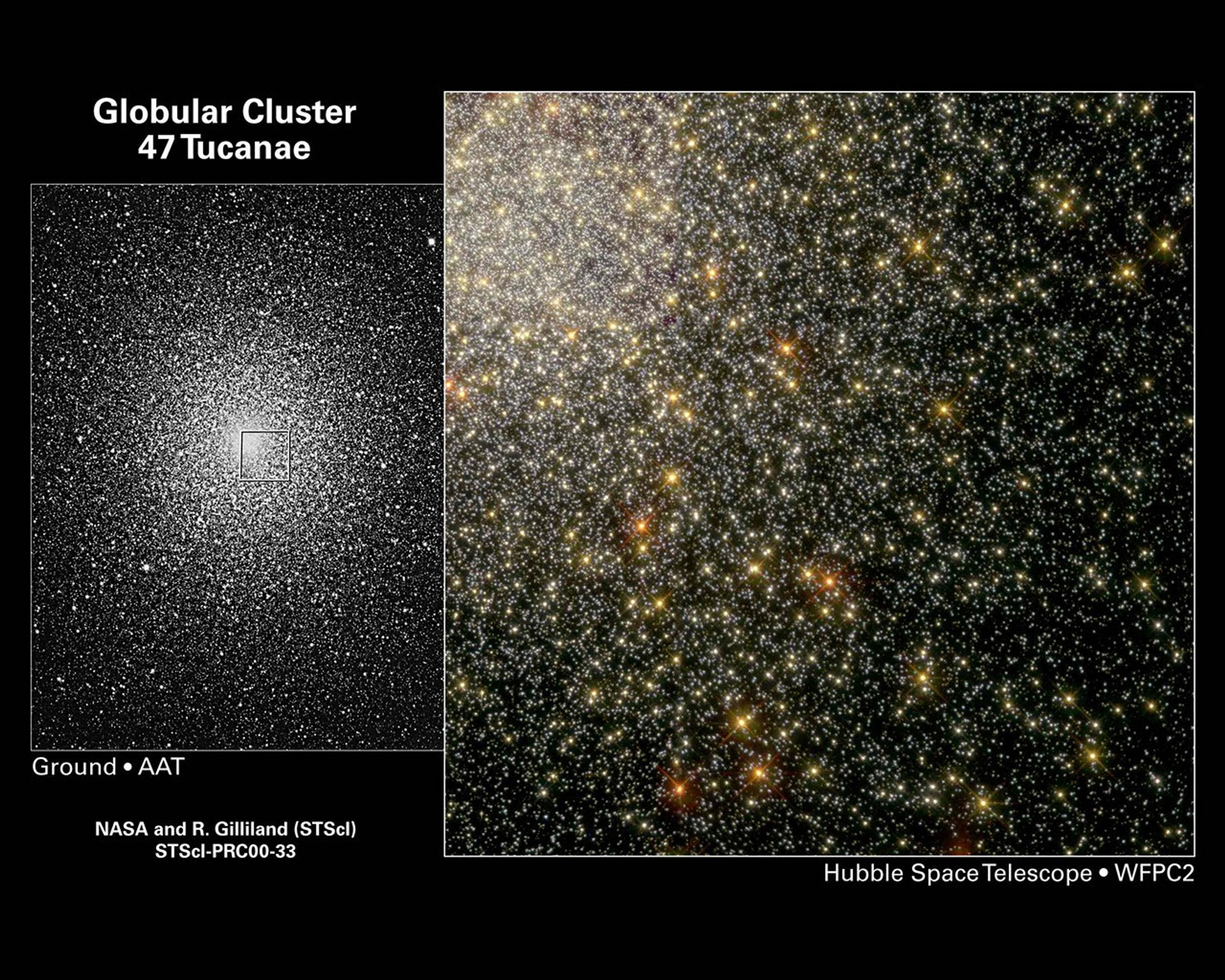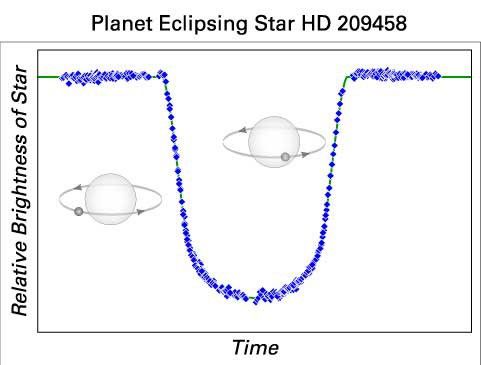1 min read
Hubble Sees a Vast “City” of Stars

In these pictures, a "city" of a million stars glitters like a New York City skyline. The images capture the globular cluster 47 Tucanae, located 15,000 light-years from Earth in the southern constellation Tucana.
Using NASA's Hubble Space Telescope, astronomers went hunting in this large city for planetary companions: bloated gaseous planets that snuggle close to their parent stars, completing an orbit in a quick three to five days. To their surprise, they found none. This finding suggests that the cluster's environment is too hostile for breeding planets or that it lacks the necessary elements for making them.
The picture at left, taken by a terrestrial telescope, shows most of the cluster, a tightly packed group of middle-aged stars held together by mutual gravitational attraction. The box near the center represents the Hubble telescope's view.
The image at right shows the Hubble telescope's close-up look at a swarm of 35,000 stars near the cluster's central region. The stars are tightly packed together: They're much closer together than our Sun and its closest stars. The picture, taken by the Wide Field and Planetary Camera 2, depicts the stars' natural colors and tells scientists about their composition and age. For example, the red stars denote bright red giants nearing the end of their lives; the more common yellow stars are similar to our middle-aged Sun. Most of the stars in the cluster are believed to have formed about 10 billion years ago. The bright, blue stars - thought to be remnants of stellar collisions and mergers - provide a few rejuvenated, energetic stars in an otherwise old system. The Hubble picture was taken in July 1999.
About the Object
- R.A. PositionR.A. PositionRight ascension – analogous to longitude – is one component of an object's position.00h 24m 5.19s
- Dec. PositionDec. PositionDeclination – analogous to latitude – is one component of an object's position.-72° 4' 49.9"
- ConstellationConstellationOne of 88 recognized regions of the celestial sphere in which the object appears.Tucana
- DistanceDistanceThe physical distance from Earth to the astronomical object. Distances within our solar system are usually measured in Astronomical Units (AU). Distances between stars are usually measured in light-years. Interstellar distances can also be measured in parsecs.About 15,000 light-years (4.6 kpc)
- DimensionsDimensionsThe physical size of the object or the apparent angle it subtends on the sky.The width of the image is 120 arcseconds (~9 light-years). Diameter: About 200 light-years. Magnitude: V4.5, B-V0.88
About the Data
- Data DescriptionData DescriptionProposal: A description of the observations, their scientific justification, and the links to the data available in the science archive.
Science Team: The astronomers who planned the observations and analyzed the data. "PI" refers to the Principal Investigator.Principal Astronomers: R. Gilliland (STScI), T. Brown (High Altitude Observatory), A. Burrows (U. Arizona), W. Cochran (U. Texas, Austin), P. Edmonds (SAO), S. Frandsen (Aarhus U.), P. GuhaThakurta (UCSC), D. Lin (UCSC), G. Marcy (UCB), M. Mayor (Observatoire de Geneve), E. Milone (U. Calgary), D. Naef (Observatoire de Geneve), A. Sarajedini (Wesleyan U.), S. Sigurdsson (PSU), D. VandenBerg (UVic), S. Vogt (UCSC), M. Albrow (STScI), N. Baliber (U. Texas, Austin), H. Bruntt (Aarhus U.), D. Charbonneau (High Altitude Observatory), P. Choi (UCSC), J. Howell (UCSC), R. Stagg (U. Calgary), M. Williams (U. Calgary). - InstrumentInstrumentThe science instrument used to produce the data.AAT (left), and HST>WFPC2 (right)
- Exposure DatesExposure DatesThe date(s) that the telescope made its observations and the total exposure time.July 3 - 11, 1999, Exposure Time: 61.7 hours
- FiltersFiltersThe camera filters that were used in the science observations.F336W (U), F555W (V), and F814W (I)
- Object NameObject NameA name or catalog number that astronomers use to identify an astronomical object.47 Tucanae, NGC 104
- Object DescriptionObject DescriptionThe type of astronomical object.Globular Cluster
- Release DateOctober 31, 2000
- Science ReleaseAstronomers Ponder Lack of Planets in Globular Cluster
- CreditHubble image: NASA and Ron Gilliland (Space Telescope Science Institute); Ground-based image: David Malin, © Anglo-Australian Observatory

Blue: F336W (U) Green: F555W (V) Red: F814W (I)
Related Images & Videos

A Planet's Telltale Signature
This diagram illustrates how a planet passing in front of a star blocks a tiny amount of starlight. In this case, it's a planet crossing the face of a nearby star called HD 209458, located 153 light-years from Earth in the constellation Pegasus. The dip in the center of the...
Share
Details
Claire Andreoli
NASA’s Goddard Space Flight Center
Greenbelt, Maryland
claire.andreoli@nasa.gov






























